Comparative Lifecycle Assessment of Renewable Energy Investments in Public Buildings: A Case Study of an Austrian Kindergarten Under Atypical Operational Conditions
Abstract
1. Introduction
2. Comparative Review of Life Cycle Analysis Tools for Building Assessment
2.1. Existing LCA/LCC Tools and Methods
2.2. VERIFY as a Dynamic LCA/LCC Tool
3. Methodological Framework
3.1. Scenario Definition
3.1.1. Building Configuration and Renovation Action
3.1.2. Analysis Period
3.2. Data Availability
3.2.1. Economic Context: Electricity and Inflation Rates
3.2.2. Data for Energy Demand and Performance
3.3. Key Performance Indicators
4. Results and Discussion
4.1. Results
4.1.1. Comparison of Energy Performance: Low and High Usage of the Kindergarten
- Initial Peak (2021): The sharp peak observed in 2021 reflects the embodied energy associated with the installation of the PV system. This includes energy requirements for the manufacturing, transportation, and installation processes, which significantly increase PED and GWP in the first year;
- Steady Trend with Gradual Increase: Following the initial installation, PED and GWP stabilize but exhibit a gradual increase over time. This trend is driven by the 0.5% annual degradation assumed in the PV system’s performance. As the system’s efficiency declines, its renewable energy output decreases, causing a greater reliance on grid electricity to meet the building’s energy demand;
- Spikes (2031 and 2041): Distinct spikes are expected to occur in 2031 and 2041, corresponding to the replacement of the air conditioning (assumed to occur in 2031) and the heat pump (in 2041) systems. These lifecycle events temporarily increase PED due to the embodied energy required for the manufacturing and installation of the replacement components.
4.1.2. Comparison of Economic Performance: Low and High Usage of Kindergarten
- Net metering—where exported energy offsets imported energy on a 1:1 basis;
- Net billing—where exported energy is valued at a lower rate than imported energy.
4.2. Discussion
5. Conclusions
Supplementary Materials
Author Contributions
Funding
Institutional Review Board Statement
Informed Consent Statement
Data Availability Statement
Conflicts of Interest
References
- Curran, M.A.; Young, S. Report from the EPA conference on streamlining LCA. Int. J. Life Cycle Assess. 1996, 1, 57–60. [Google Scholar] [CrossRef]
- Arulnathan, V.; Heidari, M.D.; Doyon, M.; Li, E.P.H.; Pelletier, N. Economic Indicators for Life Cycle Sustainability Assessment: Going Beyond Life Cycle Costing. Sustainability 2023, 15, 13. [Google Scholar] [CrossRef]
- Nicita, A.; Squadrito, G.; Maggio, G. Life-Cycle Cost (LCC) Applied to Hydrogen Technologies: A Review. Int. J. Life Cycle Assess. 2023, 29, 46–79. [Google Scholar] [CrossRef]
- World Economic Forum. Retrofitted Buildings: Accelerating the Energy Transition Through Sustainability. 2024. Available online: https://www.weforum.org/stories/2024/01/retrofitted-buildings-energy-transition/ (accessed on 1 September 2024).
- Quaschning, V. Understanding Renewable Energy Systems; Earthscan: London, UK, 2005. [Google Scholar] [CrossRef]
- Zulfiqar, F.; Muhammad-Sukki, F.; Abu-Bakar, S.H.; Bani, N.A.; Mas’Ud, A.A. Effect of COVID-19 on Photovoltaic Demand and Installation. IET Conf. Proc. 2023, 2023, 174–179. [Google Scholar] [CrossRef]
- Gui, X.; Gou, Z.; Zhang, F.; Yu, R. The Impact of COVID-19 on Higher Education Building Energy Use and Implications for Future Education Building Energy Studies. Energy Build. 2021, 251, 111346. [Google Scholar] [CrossRef]
- Saadé, M.; Erradhouani, B.; Pawlak, S.; Appendino, F.; Peuportier, B.; Roux, C. Combining Circular and LCA Indicators for the Early Design of Urban Projects. Int. J. Life Cycle Assess. 2022, 27, 1–19. [Google Scholar] [CrossRef]
- Fnais, A.; Rezgui, Y.; Petri, I.; Beach, T.; Yeung, J.; Ghoroghi, A.; Kubicki, S. The Application of Life Cycle Assessment in Buildings: Challenges, and Directions for Future Research. Int. J. Life Cycle Assess. 2022, 27, 627–654. [Google Scholar] [CrossRef]
- Braulio-Gonzalo, M.; Bovea, M.D. Environmental and Cost Performance of Building’s Envelope Insulation Materials to Reduce Energy Demand: Thickness Optimisation. Energy Build. 2017, 150, 527–545. [Google Scholar] [CrossRef]
- Bierer, A.; Götze, U.; Meynerts, L.; Sygulla, R. Integrating Life Cycle Costing and Life Cycle Assessment Using Extended Material Flow Cost Accounting. J. Clean. Prod. 2015, 108, 1289–1301. [Google Scholar] [CrossRef]
- Jiménez-Gómez, L.M.; Velásquez-Henao, J.D. A Comprehensive Analysis of Real Options in Solar Photovoltaic Projects: A Cluster-Based Approach. Heliyon 2024, 10, e35984. [Google Scholar] [CrossRef]
- Zhao, G.; Clarke, J.; Searle, J.; Lewis, R.; Baker, J. Economic Analysis of Integrating Photovoltaics and Battery Energy Storage System in an Office Building. Energy Build. 2023, 284, 112885. [Google Scholar] [CrossRef]
- Linssen, J.; Stenzel, P.; Fleer, J. Techno-Economic Analysis of Photovoltaic Battery Systems and the Influence of Different Consumer Load Profiles. Appl. Energy 2015, 153, 333–346. [Google Scholar] [CrossRef]
- Mao, D.; Yang, S.; Ma, L.; Ma, W.; Yu, Z.; Xi, F.; Yu, J. Overview of Life Cycle Assessment of Recycling End-of-Life Photovoltaic Panels: A Case Study of Crystalline Silicon Photovoltaic Panels. J. Clean. Prod. 2023, 434, 140320. [Google Scholar] [CrossRef]
- Khairi, N.H.M.; Akimoto, Y.; Okajima, K. Suitability of Rooftop Solar Photovoltaic at Educational Building Towards Energy Sustainability in Malaysia. Sustain. Horiz. 2022, 4, 100032. [Google Scholar] [CrossRef]
- Rotas, R.; Fotopoulou, M.; Drosatos, P.; Rakopoulos, D.; Nikolopoulos, N. Adaptive Dynamic Building Envelopes with Solar Power Components: Annual Performance Assessment for Two Pilot Sites. Energies 2023, 16, 2148. [Google Scholar] [CrossRef]
- Spudys, P.; Osadcha, I.; Morkunaite, L.; Manhanga, F.C.; Georgali, P.Z.; Klumbyte, E.; Jurelionis, A.; Papadopoulos, A.; Fokaides, P. A comparative life cycle assessment of building sustainability across typical European building geometries. Energy 2024, 302, 131693. [Google Scholar] [CrossRef]
- Seitaridis, A.; Mamounakis, I.; Tagkoulis, N.; Iliadis, P.; Bellos, E.; Papalexis, C.; Sougakis, V.; Nikolopoulos, N. An Innovative software platform for efficient energy, environmental and cost planning in buildings retrofitting. In IFIP International Conference on Artificial Intelligence Applications and Innovations; Maglogiannis, I., Iliadis, L., Macintyre, J., Cortez, P., Eds.; Springer International Publishing: Cham, Switzerland, 2023; pp. 217–228. [Google Scholar] [CrossRef]
- Skopetou, N.; Zestanakis, P.A.; Rotas, R.; Iliadis, P.; Papadopoulos, C.; Nikolopoulos, N.; Sfakianakis, A.; Koroneos, C. Energy Analysis and Environmental Impact Assessment for Self-Sufficient Non-Interconnected Islands: The Case of Nisyros Island. J. Clean. Prod. 2024, 447, 141647. [Google Scholar] [CrossRef]
- Bellos, E.; Iliadis, P.; Papalexis, C.; Rotas, R.; Mamounakis, I.; Sougkakis, V.; Nikolopoulos, N.; Kosmatopoulos, E. Holistic Renovation of a Multi-Family Building in Greece Based on Dynamic Simulation Analysis. J. Clean. Prod. 2022, 381, 135202. [Google Scholar] [CrossRef]
- BS EN 15978:2011; Sustainability of Construction Works—Assessment of Environmental Performance of Buildings—Calculation Method. BSI Standards Publication: London, UK, 2011. Available online: https://knowledge.bsigroup.com/products/sustainability-of-construction-works-assessment-of-environmental-performance-of-buildings-calculation-method?version=standard (accessed on 1 September 2024).
- ISO 14040:2006; Environmental Management—Life Cycle Assessment—Principles and Framework (2nd ed.). ISO: Geneva, Switzerland, 2006. Available online: https://www.iso.org/standard/37456.html (accessed on 1 September 2024).
- ISO 14044:2006; Environmental Management—Life Cycle Assessment—Requirements and Guidelines. ISO: Geneva, Switzerland, 2006. Available online: https://www.iso.org/standard/38498.html (accessed on 1 September 2024).
- BS EN 15804:2012+A2:2019; Sustainability of Construction Works—Environmental Product Declarations—Core Rules for the Product Category of Construction Products. British Standards Institution: London, UK, 2013. Available online: https://shop.bsigroup.com (accessed on 1 September 2024).
- BS ISO 15686-5:2017; Buildings and Constructed Assets—Service Life Planning—Part 5: Life-Cycle Costing. British Standards Institution: London, UK, 2017. Available online: https://knowledge.bsigroup.com/products/organization-and-digitization-of-information-about-buildings-and-civil-engineering-works-including-building-information-modelling-bim-information-management-using-building-information-modelling-health-and-safety-information-1?version=standard&creative=730824407410&keyword=building%20information%20modelling%20iso&matchtype=b&network=g&device=c&gad_source=1&gclid=Cj0KCQiAwtu9BhC8ARIsAI9JHalpeL9SZHKyzAEQzD6md7Y_vzMfZfV6bWQwQkLk2NEjqP3yy7DXqQ0aAjz0EALw_wcB&gclsrc=aw.ds (accessed on 1 September 2024).
- prEN 15459:2006; Energy Efficiency for Buildings—Economic Evaluation Procedure for Energy Systems. European Committee for Standardization: Brussels, Belgium, 2006. Available online: https://www.cen.eu (accessed on 1 September 2024).
- BS EN 16627:2015; Sustainability of Construction Works—Assessment of Economic Performance of Buildings—Calculation Methods. British Standards Institution: London, UK, 2015. Available online: https://www.en-standard.eu/bs-en-16627-2015-sustainability-of-construction-works-assessment-of-economic-performance-of-buildings-calculation-methods/?srsltid=AfmBOorchUHeLxVubXRAYpAatxgwcLrsbgIkSsmu78Hap37nwpsLO7Sc (accessed on 1 September 2024).
- Dodd, N.; Donatello, S.; Cordella, M. Level(s) Indicator 1.1: Use Stage Energy Performance User Manual: Introductory Briefing, Instructions and Guidance (Publication version 1.2). European Commission, Joint Research Centre. 2021. Available online: https://susproc.jrc.ec.europa.eu/product-bureau//sites/default/files/2021-01/UM3_Indicator_1.1_v1.1_25pp.pdf (accessed on 1 September 2024).
- Dodd, N.; Donatello, S.; Cordella, M. Level(s) Indicator 1.2: Life Cycle Global Warming Potential (GWP) User Manual: Introductory Briefing, Instructions, and Guidance (Publication version 1.1). European Commission, Joint Research Centre. 2021. Available online: https://susproc.jrc.ec.europa.eu/product-bureau/sites/default/files/2021-01/UM3_Indicator_1.2_v1.1_37pp.pdf (accessed on 1 September 2024).
- Dodd, N.; Donatello, S.; Cordella, M. Level(s) Indicator 6.1: Life Cycle Costs User Manual: Introductory Briefing, Instructions, and Guidance (Publication version 1.1). European Commission, Joint Research Centre. 2021. Available online: https://susproc.jrc.ec.europa.eu/product-bureau/sites/default/files/2021-01/UM3_Indicator_6.1_v1.1_21pp.pdf (accessed on 1 September 2024).
- Huang, B.; Wang, Y.; Huang, Y.; Xu, X.; Chen, X.; Duan, L.; Yu, G.; Li, Z.; Liu, H.; Kua, H.W.; et al. Life Cycle Cost Analysis of Solar Energy via Environmental Externality Monetization. Sci. Total. Environ. 2022, 856, 158910. [Google Scholar] [CrossRef]
- De Wolf, C.; Cordella, M.; Dodd, N.; Byers, B.; Donatello, S. Whole Life Cycle Environmental Impact Assessment of Buildings: Developing Software Tool and Database Support for the EU Framework Level(s). Resour. Conserv. Recycl. 2022, 188, 106642. [Google Scholar] [CrossRef]
- Amoruso, F.M.; Schuetze, T. Carbon Life Cycle Assessment and Costing of Building Integrated Photovoltaic Systems for Deep Low-Carbon Renovation. Sustainability 2023, 15, 9460. [Google Scholar] [CrossRef]
- Herrando, M.; Elduque, D.; Javierre, C.; Fueyo, N. Life Cycle Assessment of Solar Energy Systems for the Provision of Heating, Cooling and Electricity in Buildings: A Comparative Analysis. Energy Convers. Manag. 2022, 257, 115402. [Google Scholar] [CrossRef]
- PRé Sustainability. SimaPro Software for Life Cycle Assessment. 2023. Available online: https://simapro.com (accessed on 1 September 2024).
- Athena Sustainable Materials Institute. Athena Impact Estimator for Buildings. 2023. Available online: https://athenasmi.org/our-software-data/impact-estimator/ (accessed on 1 September 2024).
- Wikipedia contributors. RETScreen. Wikipedia, The Free Encyclopedia. 2024. Available online: https://en.wikipedia.org/wiki/RETScreen (accessed on 1 September 2024).
- One Click LCA Ltd. One Click LCA: Life Cycle Assessment Software. 2023. Available online: https://www.oneclicklca.com (accessed on 1 September 2024).
- KieranTimberlake Research Group. Tally: Life Cycle Assessment in Building Information Modeling. 2023. Available online: https://choosetally.com (accessed on 1 October 2024).
- Kitsopoulou, A.; Ziozas, N.; Iliadis, P.; Bellos, E.; Tzivanidis, C.; Nikolopoulos, N. Energy performance analysis of alternative building retrofit interventions for the four climatic zones of Greece. J. Build. Eng. 2024, 87, 109015. [Google Scholar] [CrossRef]
- Ziozas, N.; Kitsopoulou, A.; Bellos, E.; Iliadis, P.; Gonidaki, D.; Angelakoglou, K.; Nikolopoulos, N.; Ricciuti, S.; Viesi, D. Energy Performance Analysis of the Renovation Process in an Italian Cultural Heritage Building. Sustainability 2024, 16, 2784. [Google Scholar] [CrossRef]
- Kitsopoulou, A.; Zacharis, A.; Ziozas, N.; Bellos, E.; Iliadis, P.; Lampropoulos, I.; Chatzigeorgiou, E.; Angelakoglou, K.; Nikolopoulos, N. Dynamic Energy Analysis of Different Heat Pump Heating Systems Exploiting Renewable Energy Sources. Sustainability 2023, 15, 11054. [Google Scholar] [CrossRef]
- Apostolopoulos, V.; Mamounakis, I.; Seitaridis, A.; Tagkoulis, N.; Kourkoumpas, D.-S.; Iliadis, P.; Angelakoglou, K.; Nikolopoulos, N. An integrated life cycle assessment and life cycle costing approach towards sustainable building renovation via a dynamic online tool. Appl. Energy 2023, 334, 120710. [Google Scholar] [CrossRef]
- Bellos, E.; Iliadis, P.; Papalexis, C.; Rotas, R.; Nikolopoulos, N.; Kosmatopoulos, E.; Halmdienst, C. Dynamic investigation of centralized and decentralized storage systems for a district heating network. J. Energy Storage 2022, 56, 106072. [Google Scholar] [CrossRef]
- Violidakis, I.; Atsonios, K.; Iliadis, P.; Nikolopoulos, N. Dynamic modeling and energy analysis of renewable heating and electricity systems at residential buildings using phase change material based heat storage technologies. J. Energy Storage 2020, 32, 101942. [Google Scholar] [CrossRef]
- Modelica Association. Modelica: A Unified Object-Oriented Language for Physical Systems Modeling. Modelica Association. 2024. Available online: https://modelica.org/ (accessed on 1 September 2024).
- ecoinvent Association. Ecoinvent Database v3. Ecoinvent. 2024. Available online: https://ecoinvent.org/ (accessed on 1 September 2024).
- Joint Research Centre (JRC). Emission factors for CO2 equivalent (CO2-eq) emissions in EU Member States (1990–2021). European Commission. 2021. Available online: https://data.jrc.ec.europa.eu/dataset/919df040-0252-4e4e-ad82-c054896e1641 (accessed on 1 September 2024).
- Seber, G.A.F.; Wild, C.J. Nonlinear Regression; John Wiley & Sons: Hoboken, NJ, USA, 2003. [Google Scholar] [CrossRef]
- Eurostat. Electricity Prices for Household Consumers (NRG_PC_204). European Commission. 2023. Available online: https://ec.europa.eu/eurostat/databrowser/view/nrg_pc_204/default/table?lang=en (accessed on 1 September 2024).
- Inflation.eu. Historic Inflation Austria—CPI Inflation Austria 2021. 2023. Available online: https://www.inflation.eu/en/inflation-rates/austria/historic-inflation/cpi-inflation-austria-2021.aspx (accessed on 1 September 2024).
- European Central Bank. The Impact of the Pandemic and the War: Insights from the ECB’s Consumer Expectations Survey. Economic Bulleti. 2022. Available online: https://www.ecb.europa.eu/press/economic-bulletin/focus/2022/html/ecb.ebbox202204_01~68ef3c3dc6.en.html (accessed on 1 September 2024).
- International Energy Agency (IEA). Eco-Social Tax Reform Act (Austria ETS); IEA: Paris, France, 2024; Available online: https://www.iea.org/policies/13998-eco-social-tax-reform-act-austria-ets (accessed on 1 September 2024).
- Taxually. Austria VAT Rate and Compliance 2024. Taxually. 2024. Available online: https://www.taxually.com/blog/austria-vat-rate-and-compliance-2024 (accessed on 1 September 2024).
- Dufo-López, R.; Bernal-Agustín, J.L. A comparative assessment of net metering and net billing policies. Study cases for Spain. Energy 2015, 84, 684–694. [Google Scholar] [CrossRef]
- International Energy Agency (IEA). Cost of Capital by Project Type in Selected Countries; IEA: Paris, France, 2022; Available online: https://www.iea.org (accessed on 1 September 2024).
- Amann, C.; Torres, P.; Boldizsár, G.; Hofer, G.; Stumpf, W.; Leutgöb, K.; van Nuffel, L. Support to Primary Energy Factors Review (PEF): Final Report. European Commission Directorate-General for Energy. 2023. Available online: https://ec.europa.eu (accessed on 1 September 2024).
- International Energy Agency Photovoltaic Power Systems Programme (IEA-PVPS). National Survey Report of PV Power Applications in Austria 2023. 2023. Available online: https://iea-pvps.org/wp-content/uploads/2024/10/National-Survey-Report-of-PV-Power-Applications-in-Austria-2023.pdf (accessed on 1 September 2024).
- Wikipedia Contributors. COVID-19 Pandemic in Austria. Wikipedia, The Free Encyclopedia. 2024. Available online: https://en.wikipedia.org/wiki/COVID-19_pandemic_in_Austria (accessed on 1 September 2024).
- Brychkov, D.; Goggins, G.; Doherty, E.; Romero, N.; Roudil, N.; Di Trani, A.; Singh, A.; Smit, S.; McLoughlin, E.; Lima, R.d.C.R.; et al. A systemic framework of energy efficiency in schools: Experiences from six European countries. Energy Effic. 2023, 16, 21. [Google Scholar] [CrossRef]
- Kabeyi, M.J.B.; Olanrewaju, O.A. The levelized cost of energy and modifications for use in electricity generation planning. Energy Rep. 2023, 9, 495–534. [Google Scholar] [CrossRef]
- Fraunhofer Institute for Solar Energy Systems ISE. “Levelized Cost of Electricity—Renewables Clearly Superior to Conventional Power Plants Due to Rising CO2 Prices”. 2021. Available online: https://www.ise.fraunhofer.de (accessed on 1 September 2024).
- The Constructor. Energy Efficiency in Buildings—Need, Benefits, and Methods. 2023. Available online: https://theconstructor.org/building/buildings/energy-efficiency-building/562100/ (accessed on 1 September 2024).
- Energy Theory. Net Billing vs Net Metering: Key Differences and Benefits. 2024. Available online: https://energytheory.com/net-billing-vs-net-metering/ (accessed on 1 September 2024).
- Pachta, V.; Giourou, V. Comparative Life Cycle Assessment of a Historic and a Modern School Building, Located in the City of Naoussa, Greece. Sustainability 2022, 14, 4216. [Google Scholar] [CrossRef]
- Bilir, L.; Yildirim, N. Photovoltaic System Assessment for a School Building. Int. J. Hydrogen Energy 2017, 42, 17856–17868. [Google Scholar] [CrossRef]
- European Commission. Energy School—Guardians of Smart Energy Schools. Available online: https://ec.europa.eu/regional_policy/projects/projects-database/energy-school-guardians-of-smart-energy-schools_en (accessed on 1 September 2024).

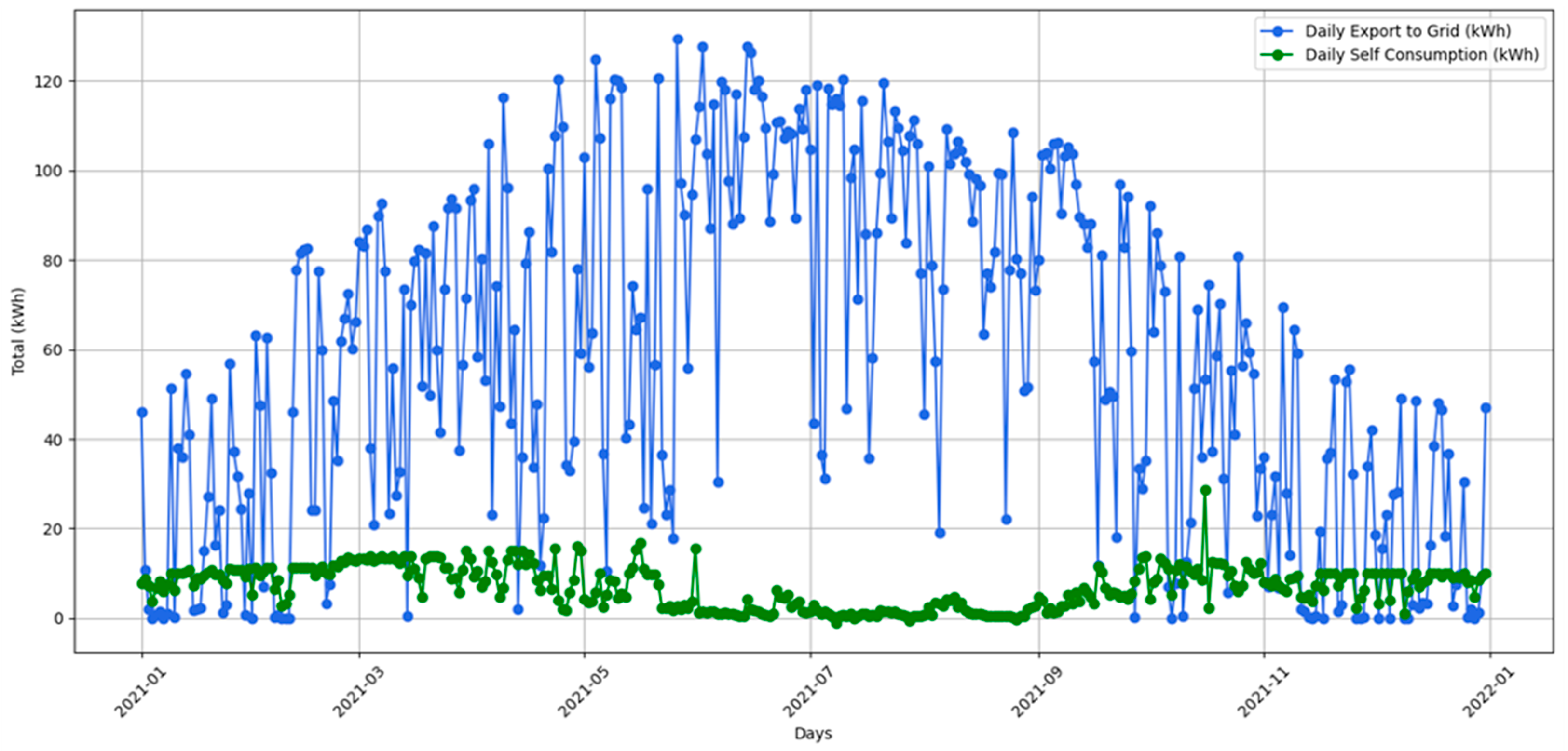
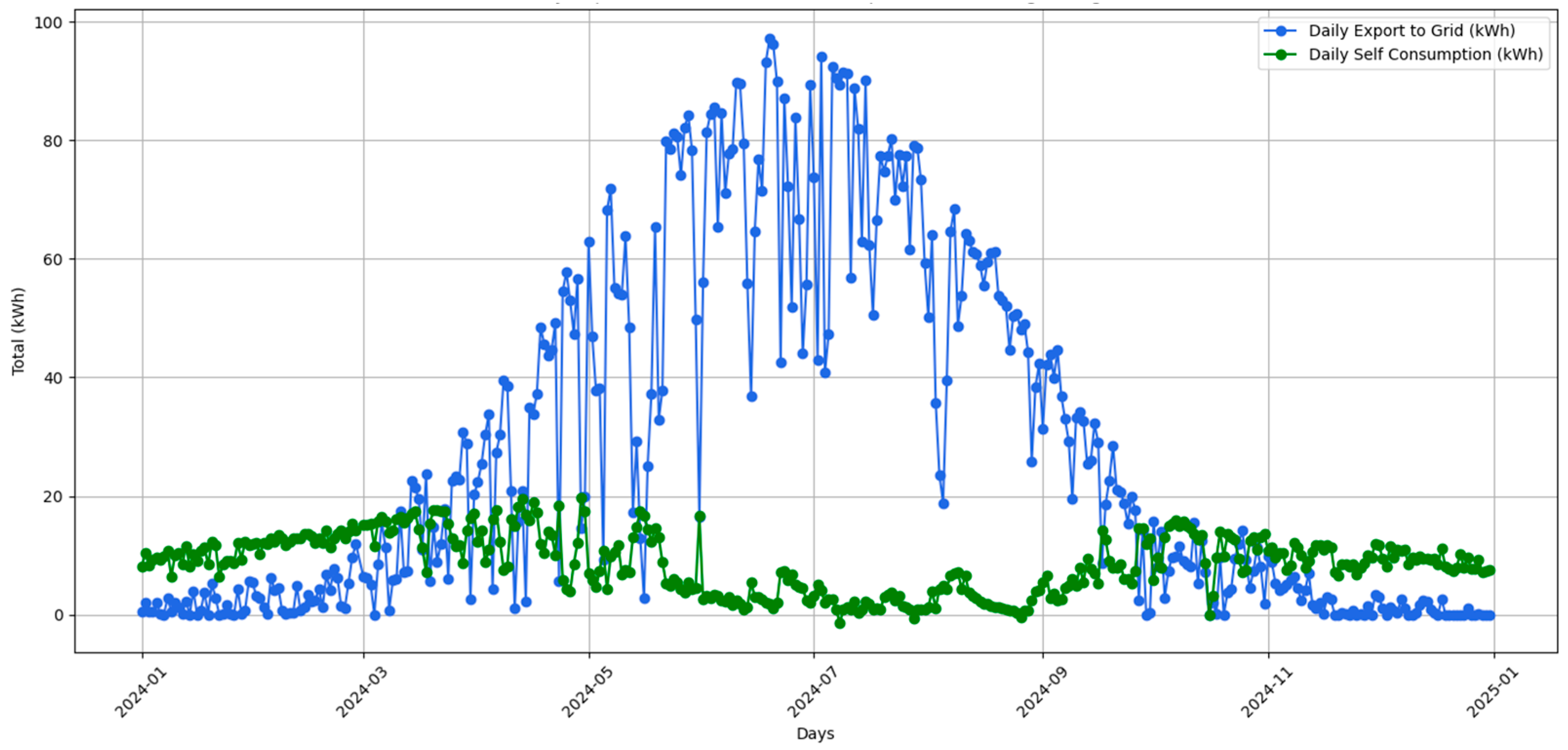
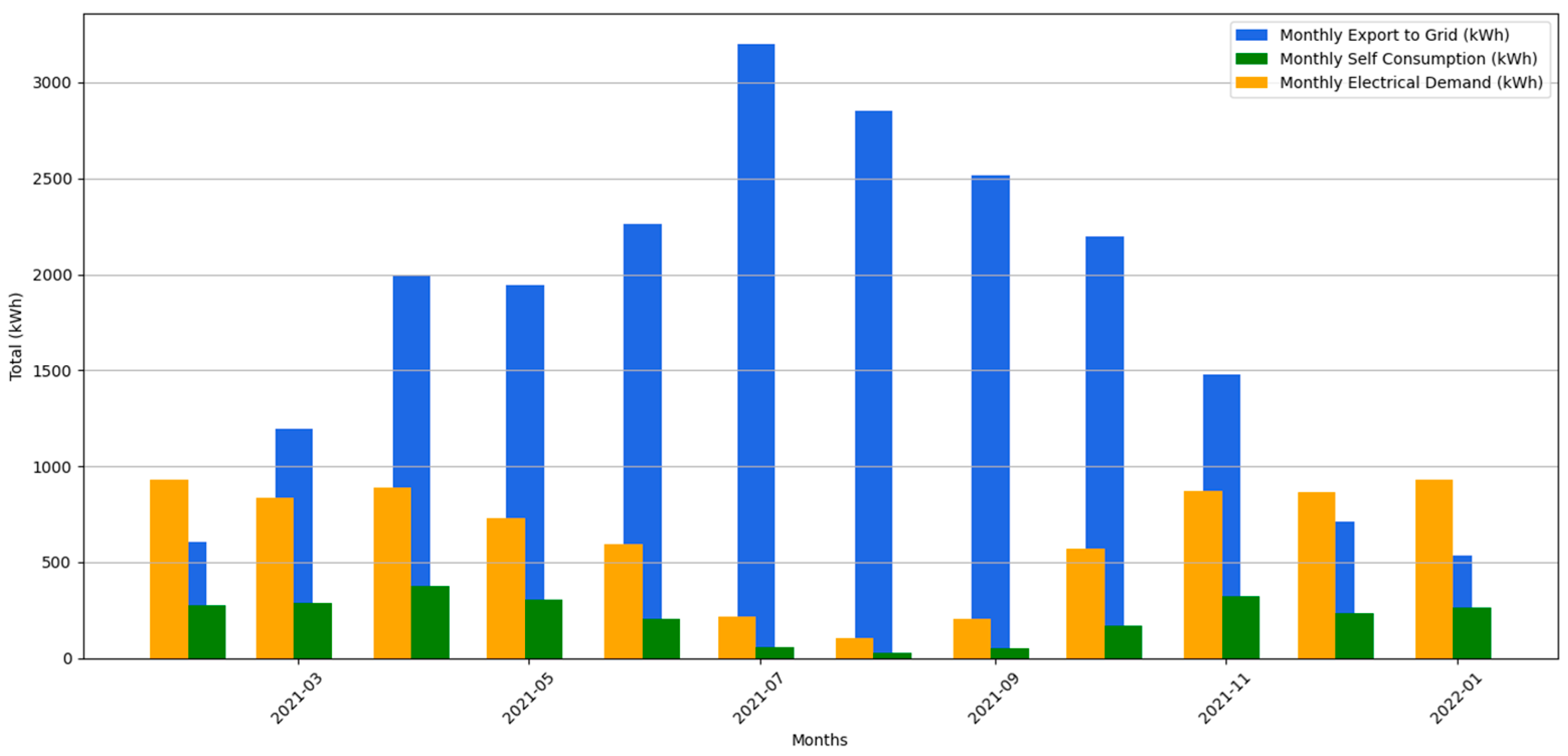
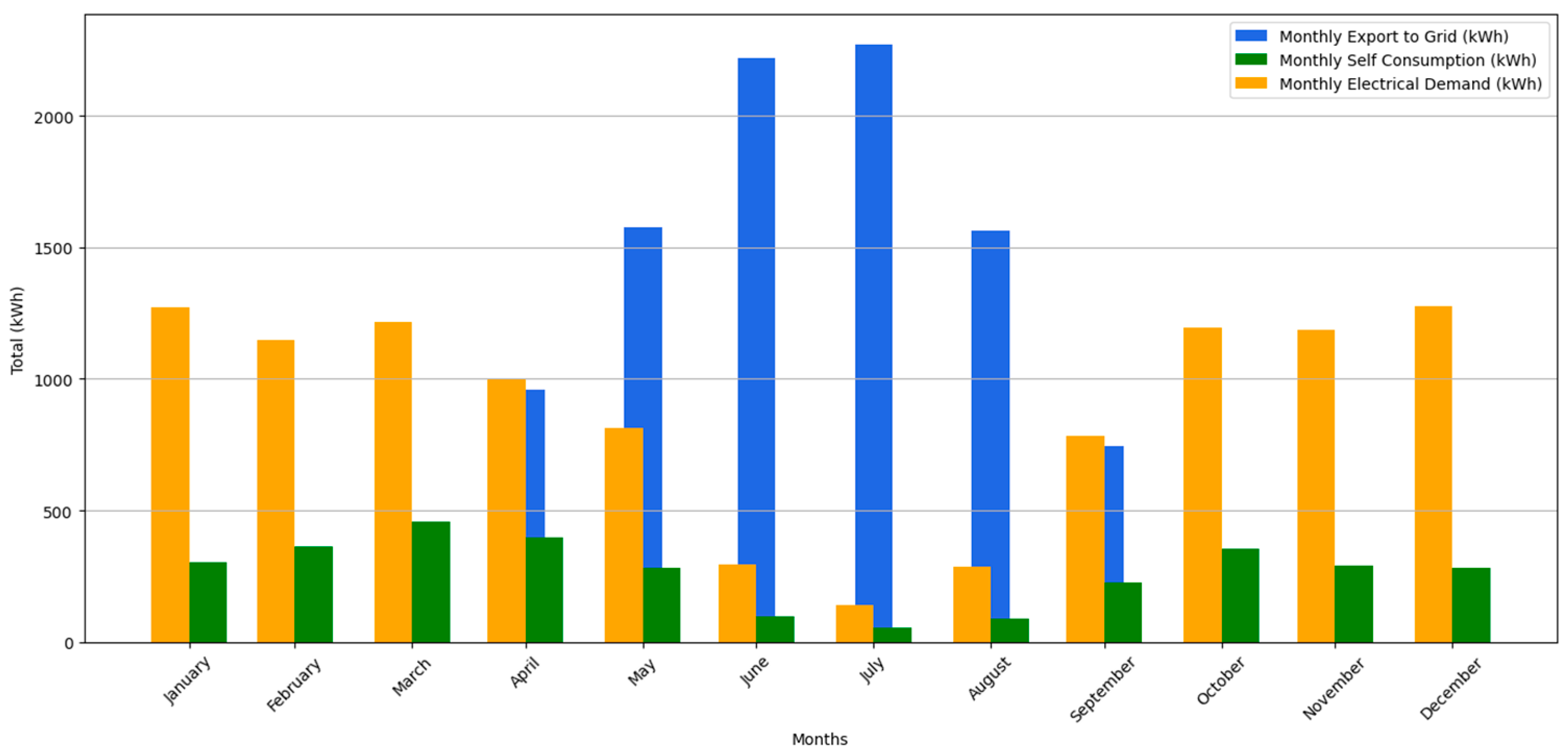
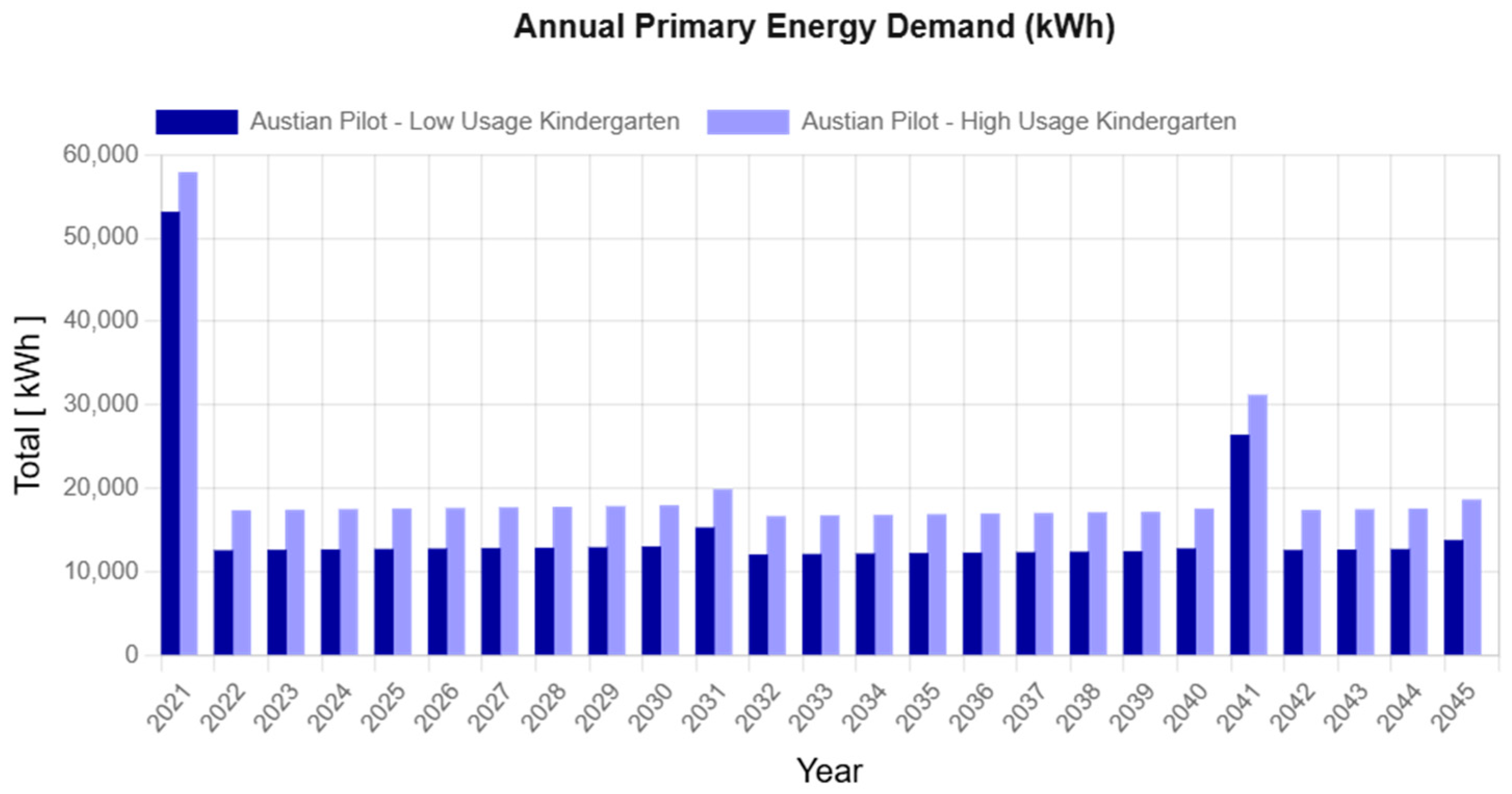
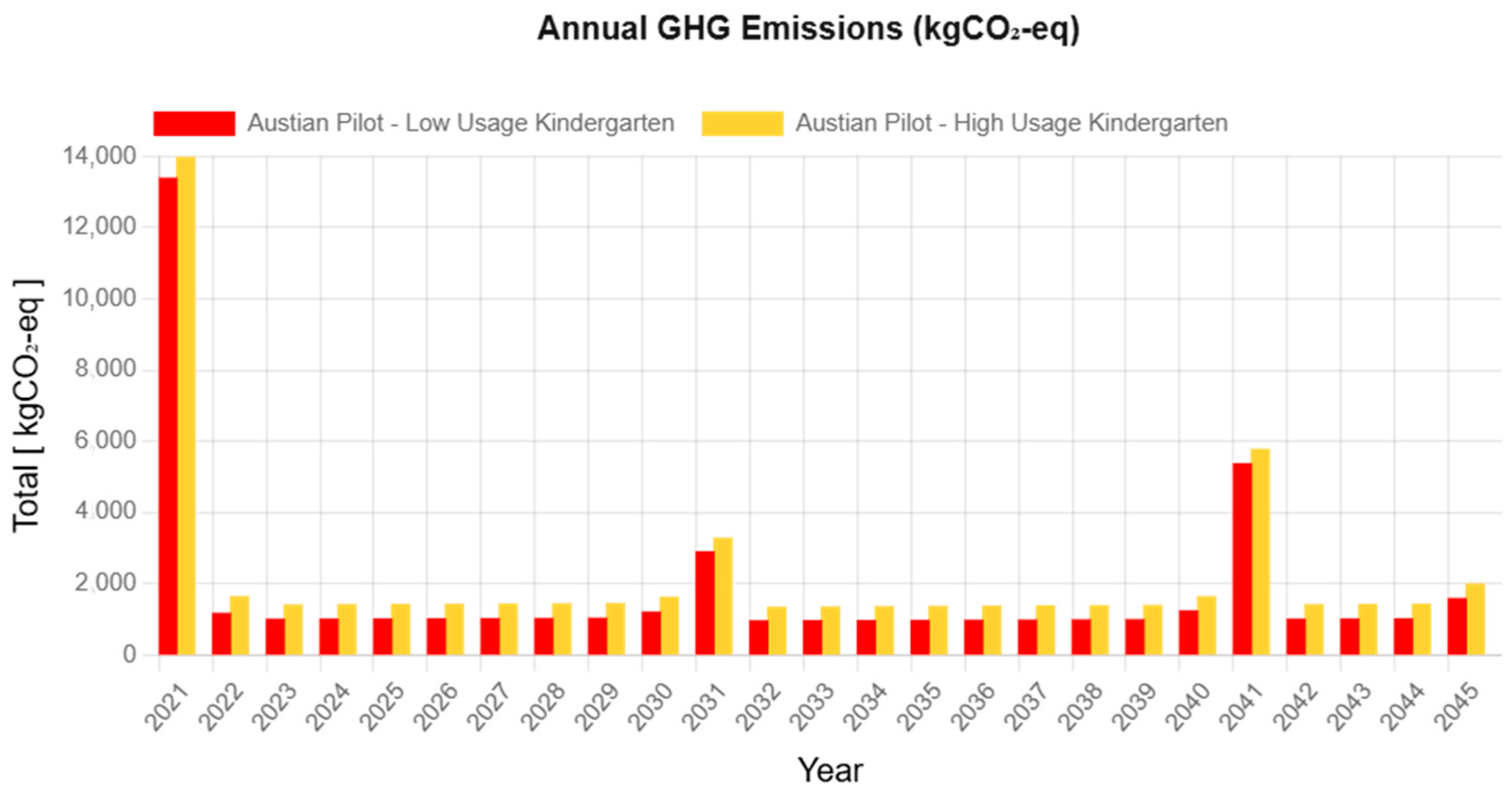

| Parameter | Details |
|---|---|
| Project Name | SBA1 Kindergarten |
| Location | Southern Burgenland, Austria (Latitude: 47.0145, Longitude: 16.4579) |
| Building Type | Public Kindergarten |
| Building Structure | Single-story, primarily brick construction |
| Total Floor Area | 168.85 m2 |
| Operation Schedule | Year-round |
| External Wall Material | Brick |
| Number of Floors | 1 |
| Operational Parameters | Net billing buyback scheme |
| Primary Energy Source | Electricity |
| Component | Details |
|---|---|
| Heating System | Heat Pump Air-to-Water |
| Thermal Rating (kW) | 9.6 |
| Heating Efficiency | 2.5 |
| Lifetime (years) | 20 |
| Heating Purchase Cost (EUR) | 6720.00 |
| Heating Maintenance Cost (EUR/year) | 490.56 |
| Cooling System | Basic Air Conditioning |
| Thermal Rating (kW) | 7.5 |
| Cooling COP | 2.5 |
| Lifetime (years) | 20 |
| Cooling System Purchase Cost (EUR) | 1298.08 |
| Cooling System Maintenance Cost (EUR/year) | 51.92 |
| Insulation Material | Extruded Polystyrene |
| Thickness (mm) | 100 |
| Surface Area (m2) | 110.3 |
| Coverage | All Walls |
| Lifetime (years) | 100 |
| Insulation Purchase Cost (EUR) | 3131.90 |
| Glazing Type | Double Glazing (Double/Float 4–16–4 (Air)) |
| Glazing Opening Surface (m2) | 160.61 |
| Frame Material | Aluminium Frame (20% Frame Coverage) |
| Glazing Lifetime (years) | 40 |
| Glazing Purchase Cost (EUR) | 51,652.18 |
| Glazing Maintenance Cost (EUR/year) | 25.83 |
| Tank for Domestic Hot Water | Copper Tank |
| Tank Capacity (L) | 600 |
| Electricity Rating (kW) | 5 |
| Lifetime (years) | 20 |
| DHW Purchase Cost (EUR) | 1681.79 |
| DHW Maintenance Cost (EUR/year) | 16.82 |
| PV System Parameter | Details |
|---|---|
| Mounting | Roof-slanted PV System |
| PV Panel Material | Polycrystalline-Si |
| Reference Capacity (kWp) | 20.14 |
| PV Purchase Cost (EUR) | 19,334.40 |
| Lifetime of PV System (years) | 30 |
| Component | Stage A—PE Demand (GJ) | Stage A—GWP (kgCO2-eq) |
|---|---|---|
| Heat Pump Air-to-Water | 6.32 | 1526.4 |
| Basic Air Conditioning | 0.0525 | 3525 |
| Insulation | 74.44 | 3187.31 |
| Glazing | 62.48 | 5460.74 |
| Domestic Hot Water | 10.1 | 868 |
| PV System | 1770 | 11,882.6 |
| Parameter | Value | Units |
|---|---|---|
| Primary Energy Factor | 1.91 | KWhP/kWh |
| CO2-eq Emission Factors | 2021: 0.281 | kg/kWh |
| 2022: 0.225 | ||
| 2023: 0.192 | ||
| 2024: 0.312 |
| Prices | Average of 2021 | 2024 | 2024 (Without Subsidy) |
|---|---|---|---|
| Import Price (EUR/kWh) | 0.2251 | 0.2731 | 0.3878 |
| Export Price (EUR/kWh) | 0.1421 | 0.2946 | 0.2946 |
| Buyback Price (EUR/kWh) | 0.0635 | 0.0771 | 0.0836 |
| Inflation Rate (%) | 2.76 | 3.48 | |
| Case | Electrical Demand (kWh/year) | PV Production (kWh/year) | CAPEX (EUR) |
|---|---|---|---|
| Low Usage | 7739 | 24,066.99 | 27,158.79 |
| High Usage (Large PV) | 10,608.35 | 24,066.99 | 29,897.83 |
| High Usage (Small PV) | 13,431.66 | 16,687.37 |
| KPI Name | Equation | Units | Description |
|---|---|---|---|
| Environmental KPIs | |||
| Global Warming Potential (GWP) | with | kg CO2-eq/m2 | : Total greenhouse gas emissions over the lifecycle Useful Area: Building area with heating/cooling access : Operational GHG emissions of the building’s components in year i; : infrastructure (embodied) GHG emissions. |
| Primary Energy Demand (PED) | kWh | : Energy demand during infrastructure/construction phases : Operational/maintenance energy demand during building’s use stage | |
| Economic KPIs | |||
| Lifecycle Costs (LCC) | EUR | : Infrastructure costs (CAPEX) : operational net costs, including energy consumption and maintenance : Residual value of components at end of lifecycle | |
| Whole Life Cost (WLC) | EUR | : Infrastructure costs (CAPEX) : operational costs (energy consumption/maintenance and operational revenues due to electricity exports from RES : Residual value of components at end of lifecycle | |
| Renewable Energy System (RES) Payback Period | Years | : Last year before cumulative savings meet or exceed RES investment : Remaining fraction of the year required for full payback of RES investment | |
| Levelized Cost of Electricity (LCOE) | EUR/kWh | : generator infrastructure costs : annual generator maintenance costs (which include replacement costs if the analysis period exceeds the generators’ lifetime) : costs of fuel used for electricity generation (applicable only in the case of electricity generators using other fuel) and : total energy self-consumed and exported by the building project discount rate | |
| Net Present Value (NPV) | EUR | Ri: revenue or savings in period I Ci: cost in period i, when i = 0 the C0 is the initial investment r: project discount rate i: period index | |
| Return on Investment (ROI) | ratio | NPV: Net Present Value Initial Investment: capital expenditure at the beginning of the project | |
| Environmental KPIs | Without PV | Low Usage | High Usage | |||
|---|---|---|---|---|---|---|
| Lifetime Primary Energy Demand (kWh) Lifetime Primary Energy Demand Per m2 (kWh/m2) | Total | Annual Avg. | Total | Annual Avg. | Total | Annual Avg. |
| 547,941 | 21,917.63 | 385,040 | 15,401.61 | 510,024 | 20,400.98 | |
| 3245.13 | 129.81 | 2280.37 | 91.21 | 3020.57 | 120.82 | |
| Lifetime Global Warming Potential (kgCO2-eq) | 61,868.07 | 2474.72 | 45,975.52 | 1839.02 | 56,796.02 | 2271.84 |
| Lifetime Global Warming Potential per m2 (kgCO2-eq/m2) | 366.41 | 14.66 | 272.29 | 10.89 | 336.37 | 13.45 |
| Net Metering Buyback | Life Cycle Costs (LCC, EUR) | Annual Avg. LCC (EUR/year) | Whole Life Cycle Costs (WLC, EUR) | Annual Avg. WLC (EUR/Year) | PV Payback Period (Years) | Net Billing Buyback | Life Cycle Costs (LCC, EUR) | Annual Avg. LCC (EUR/Year) | Whole Life Cycle Costs (WLC, EUR) | Annual Avg. WLC (EUR/Year) | PV Payback Period (Years) |
|---|---|---|---|---|---|---|---|---|---|---|---|
| High Usage | |||||||||||
| Yearly | 60,882.41 | 2435.30 | 34,148.97 | 1365.96 | 9.04 | Yearly | 60,882.41 | 2435.30 | 33,450.65 | 1338.03 | 8.9 |
| Yearly without subsidy | 60,882.41 | 2435.30 | 32,908.38 | 1248.39 | 6.34 | Yearly without subsidy | 60,882.41 | 2435.30 | 36,190.72 | 1447.63 | 6.63 |
| Quarterly | 62,971.64 | 2518.87 | 35,648.38 | 1425.94 | 9.28 | Quarterly | 62,176.11 | 2487.04 | 34,405.78 | 1376.23 | 9.05 |
| Monthly | 67,190.23 | 2678.61 | 38,676.01 | 1547.04 | 9.9 | Monthly | 66,668.47 | 2666.74 | 37,722.44 | 1508.90 | 9.7 |
| Daily | 71,589.03 | 2863.56 | 41,832.96 | 1673.96 | 10.65 | Daily | 71,320.82 | 2852.83 | 41,157.22 | 1646.29 | 10.28 |
| Low Usage | |||||||||||
| Yearly | 58,143.37 | 2325.74 | 31,085.44 | 1243.42 | 12.94 | Yearly | 58,143.37 | 2325.74 | 34,363.04 | 1374.52 | 14.46 |
| Quarterly | 58,143.37 | 2325.74 | 31,085.44 | 1243.42 | 12.94 | Quarterly | 59,471.80 | 2378.87 | 35,097.94 | 1403.91 | 14,82 |
| Monthly | 59,498.15 | 2379.93 | 32,058.04 | 1282.32 | 13,31 | Monthly | 61,765.93 | 2470.63 | 36,366.78 | 1454.67 | 15.56 |
| Daily | 63,275.30 | 2531.01 | 34,769.67 | 1390.79 | 14.66 | Daily | 64,080.84 | 2563.23 | 37,647.24 | 1505.89 | 16.38 |
| High Usage Small PV | |||||||||||
| Yearly | 47,671.95 | 1906.88 | 34,446.04 | 1377.84 | 6.01 | Yearly | 47,671.95 | 1906.88 | 33,709.74 | 1348.39 | 5.91 |
| Quarterly | 69,072.04 | 2762.88 | 49,804.58 | 1992.18 | 9.3 | Quarterly | 68,796.94 | 2751.88 | 49,306.10 | 1972.24 | 9.13 |
| Monthly | 69,072.04 | 2762.88 | 49,804.58 | 1992.18 | 9.3 | Monthly | 68,796.94 | 2751.88 | 49,306.10 | 1972.24 | 9.13 |
| Daily | 70,683.86 | 2827.35 | 50,961.36 | 2038.45 | 9.7 | Daily | 70,311.96 | 2812.48 | 50,424.62 | 2016.99 | 9.5 |
| Scenarios | LCOE (EUR/kWh) |
|---|---|
| High Usage | 0.0885 |
| Low Usage | 0.0811 |
| High Usage (Small PV) | 0.0948 |
Disclaimer/Publisher’s Note: The statements, opinions and data contained in all publications are solely those of the individual author(s) and contributor(s) and not of MDPI and/or the editor(s). MDPI and/or the editor(s) disclaim responsibility for any injury to people or property resulting from any ideas, methods, instructions or products referred to in the content. |
© 2025 by the authors. Licensee MDPI, Basel, Switzerland. This article is an open access article distributed under the terms and conditions of the Creative Commons Attribution (CC BY) license (https://creativecommons.org/licenses/by/4.0/).
Share and Cite
Kousovista, G.; Iakovides, G.; Petridis, S.; Chairopoulos, N.-C.; Skembris, A.; Fotopoulou, M.; Antipa, D.; Nikolopoulos, N.; Rakopoulos, D. Comparative Lifecycle Assessment of Renewable Energy Investments in Public Buildings: A Case Study of an Austrian Kindergarten Under Atypical Operational Conditions. Appl. Sci. 2025, 15, 2330. https://doi.org/10.3390/app15052330
Kousovista G, Iakovides G, Petridis S, Chairopoulos N-C, Skembris A, Fotopoulou M, Antipa D, Nikolopoulos N, Rakopoulos D. Comparative Lifecycle Assessment of Renewable Energy Investments in Public Buildings: A Case Study of an Austrian Kindergarten Under Atypical Operational Conditions. Applied Sciences. 2025; 15(5):2330. https://doi.org/10.3390/app15052330
Chicago/Turabian StyleKousovista, Georgia, Giannis Iakovides, Stefanos Petridis, Nikolaos-Charalampos Chairopoulos, Angelos Skembris, Maria Fotopoulou, Despina Antipa, Nikolaos Nikolopoulos, and Dimitrios Rakopoulos. 2025. "Comparative Lifecycle Assessment of Renewable Energy Investments in Public Buildings: A Case Study of an Austrian Kindergarten Under Atypical Operational Conditions" Applied Sciences 15, no. 5: 2330. https://doi.org/10.3390/app15052330
APA StyleKousovista, G., Iakovides, G., Petridis, S., Chairopoulos, N.-C., Skembris, A., Fotopoulou, M., Antipa, D., Nikolopoulos, N., & Rakopoulos, D. (2025). Comparative Lifecycle Assessment of Renewable Energy Investments in Public Buildings: A Case Study of an Austrian Kindergarten Under Atypical Operational Conditions. Applied Sciences, 15(5), 2330. https://doi.org/10.3390/app15052330









